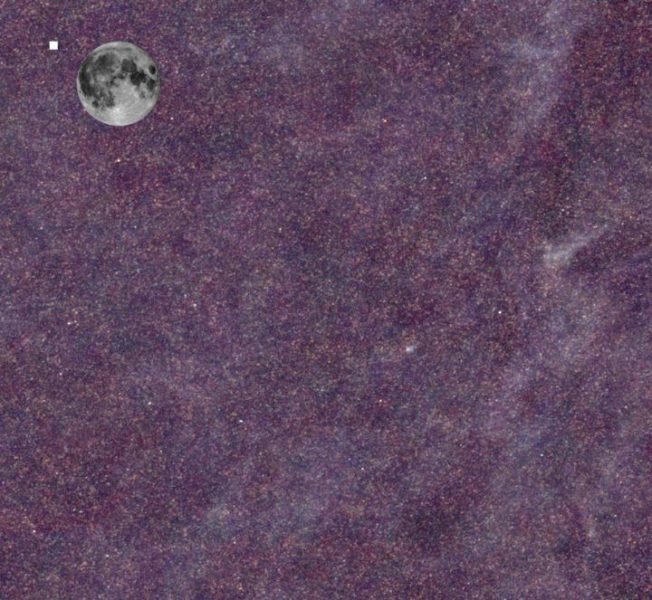The Universe is becoming gradually cleaner as more and more cosmic dust is being mopped up by the formation of stars within galaxies, an international team of astronomers has revealed.
Peering back 12 billion years using the Herschel space telescope to produce far-infrared images of the sky, the team led by researchers at Cardiff University has been able to observe the very early formation of galaxies and compare them to galaxies that have formed much more recently.
The results showed that stars were forming inside galaxies much faster in the past compared to today, and that this rapid star birth is using up more and more of the cosmic dust that is ubiquitous in the Universe.
Cosmic dust is comprised of tiny solid particles that are found everywhere in space between the stars. The dust and the gas in the universe is the raw material out of which stars and galaxies form.
Though this blanket of material is key to the formation of stars and galaxies, it also acts as a sponge, absorbing almost half of the light emitted by stellar objects and making them impossible to observe with standard optical telescopes.
With the launch of the Herschel space telescope in 2009, researchers were provided with the perfect tool for probing this hidden universe. Owing to a collection of sensitive instruments, mirrors and filters, the Herschel telescope had the capacity to detect the dust through the far-infrared emission it emits, revealing the existence of stars and galaxies hidden by the dust.
Professor Steve Eales, a co-leader of the project from Cardiff University’s School of Physics and Astronomy, said: “We were surprised to find that we didn’t need to look far in the past to see signs of galaxy evolution. Our results show that the reason for this evolution is that galaxies used to contain more dust and gas in the past, and the universe is gradually becoming cleaner as the dust is used up.”
Professor Haley Gomez, also of the School of Physics and Astronomy, presented the team’s results today, 29 June, at the National Astronomy Meeting in Nottingham. After seven years of work analysing the images from the Herschel telescope, the team of over 100 astronomers have released a large catalogue of the sources of far-infrared radiation in this ‘hidden universe’.
The team’s survey of the sky, called the Herschel Astrophysical Terahertz Large Area Survey (Herschel ATLAS), has revealed the details of over half a million galaxies, many of which have been viewed as they were over 12 billion years ago, just shortly after the big bang.
The team are hopeful that this unprecedented catalogue of sources will be vital tools for astronomers wishing to understand the detailed history of galaxies and the wider cosmos.
Dr Elisabetta Valiante, a lead author from Cardiff University’s School of Physics and Astronomy, said: “The exciting thing about our survey is that it encompasses almost all of cosmic history, from the violent star-forming systems full of dust and gas in the early universe, that are essentially galaxies in the process of formation, to the much more subdued systems we see around us today.”
Dr Loretta Dunne, a co-leader of project from Cardiff University’s School of Physics and Astronomy, said: “Before Herschel we only knew of a few hundred such dusty sources in the distant universe and we could only effectively ‘see’ them in black and white. Herschel, with its five filters, has given us the equivalent of technicolour, and the colour of the galaxy tell us about their distances and temperatures. So we now have half a million galaxies we can use to map out the hidden star formation in the universe.”
The project was jointly funded by the Science and Technology Facilities Council, the European Union’s 7th Framework Programme for Research and Technological Development, and the European Research Council.
Notes to editors
1. For further information contact:
Michael Bishop
Communications & Marketing
Cardiff University
Tel: 02920 874499
Email: [email protected]
2. Cardiff University is recognised in independent government assessments as one of Britain’s leading teaching and research universities and is a member of the Russell Group of the UK’s most research intensive universities. The 2014 Research Excellence Framework ranked the University 5th in the UK for research excellence. Among its academic staff are two Nobel Laureates, including the winner of the 2007 Nobel Prize for Medicine, University Chancellor Professor Sir Martin Evans. Founded by Royal Charter in 1883, today the University combines impressive modern facilities and a dynamic approach to teaching and research. The University’s breadth of expertise encompasses: the College of Arts, Humanities and Social Sciences; the College of Biomedical and Life Sciences; and the College of Physical Sciences and Engineering, along with a longstanding commitment to lifelong learning. Cardiff’s flagship Research Institutes are offering radical new approaches to pressing global problems. http://www.cardiff.ac.uk
If our reporting has informed or inspired you, please consider making a donation. Every contribution, no matter the size, empowers us to continue delivering accurate, engaging, and trustworthy science and medical news. Independent journalism requires time, effort, and resources—your support ensures we can keep uncovering the stories that matter most to you.
Join us in making knowledge accessible and impactful. Thank you for standing with us!

